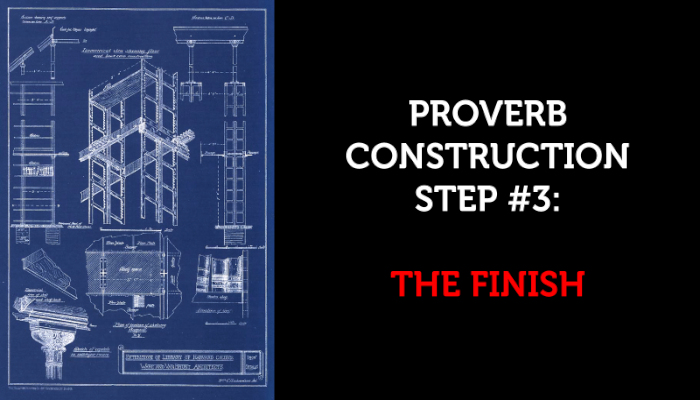
This is the last post in our series of proverb construction, so if you’re reading this first, we suggest that you go back and review:
Proverb Construction Step #1: The Function
Proverb Construction Step #2: The Frame
All written works consist of form and function. Proverbial form is split into two subcategories: frames (the structure by which we build our proverbs) and finishes (the techniques used to gussy ’em up). We’ll wrap-up our series with finishes.
Finishing is my favorite part of proverb construction because it gives me the creative freedom to add style to the drabness of function and form.
Proverb finishes come in five categories: conviction, ellipsis, negation, poetic, and wordplay:
- Conviction sets the confidence level of the proverb through using words such as always, sometimes, or never as in: sometimes blessings come in disguise
- Ellipsis truncates proverbs to just the essential words—sometimes eliminating the verb entirely, such as in: least said, soonest mended
- Negation uses negative logic to make points through words like no or not as in one swallow does not a summer make
- Poetic finishes add to the memorability and repeatability of proverbs. There are five different poetic types to consider: rhyme, rhythm, assonance, alliteration, and consonance.
- Rhyme uses a collection of same-sounding word fragments such as meet roughness with toughness
- Rhythm arranges syllables to form a beat, such as in nothing ventured, nothing gained, which follows the beat pattern of one-two; one-two; one-two-three
- Assonance is like rhyme, where it uses repeating vowel sounds. While time and nine don’t rhyme in a stitch in time saves nine, the two words are tied together through the common pronunciation of the long “I” sound
- Alliteration repeats a consonant sound at the beginning of a word, as in it takes two to tango
- Consonance is like alliteration, yet the consonance sounds are found in the middle and end of words as opposed to the front of them, such as: one day a rooster, the next day a feather duster
- Wordplay involves a clever use of words. There are four wordplay subcategories: associations, double-use, opposites, and reversals.
- Associations play with the relationships between word meanings. For example, a clever hawk hides its claws uses the association between a bird of prey and its talons
- Double-use finishes repeat words to make a point, such as in a friend to all is a friend to none
- Opposites make their points paradoxically, through contradictory or metaphorical meanings, such as one man’s gravy is another man’s poison
- Reversals are like double-use finishes because they repeat words but differ by reversing their order. For example, it’s not the size of the dog in a fight, but the size of the fight in the dog
RECAP
So, there you have it: the three steps for proverb construction:
- What’s the function of your proverb? (definition, prediction, or prescription)
- What frame will you build the proverb upon? (comparisons, conditionals, derivatives, none)
- What finishes can you add? (conviction, ellipsis, negation, poetic, or wordplay)
Give it a try.